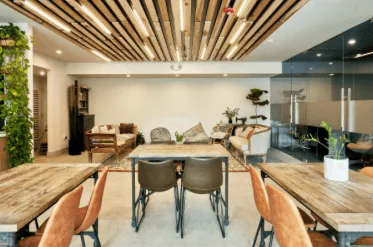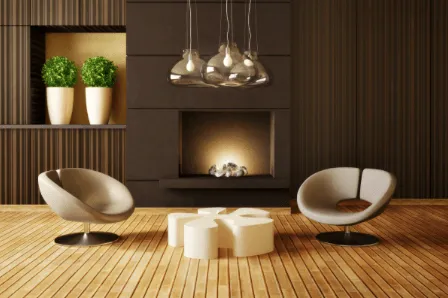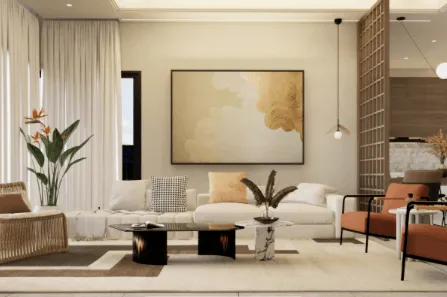Environmental Designer: Guide to Environmental Design
Discover the role of the environmental designer, their key skills, creative processes, and current trends in unique environmental design.
Environment design is a creative and technical discipline that focuses on planning and transforming spaces, both interior and exterior, with the aim of making them functional, aesthetically pleasing, and suitable for their users. It involves the strategic use of elements such as furniture, lighting, materials, and colors to create environments that positively influence people's well-being, productivity, and comfort. This field encompasses everything from residential interior decoration to the creation of large commercial projects and public spaces.
Beyond mere aesthetics, environment design considers psychological, social, and cultural aspects, ensuring that spaces have personality and purpose. For example, a work environment can be designed to foster collaboration and creativity, while a home can be designed to maximize comfort and functionality in daily life.

The Importance of the Environment Designer
The environment designer plays an essential role in transforming spaces. This professional not only has the ability to beautify a place but also to adapt it to meet the specific needs of the people who use it. From a technical and aesthetic approach, the designer balances practical aspects with visual ones, ensuring that the environment has a positive impact on its users.
Their work goes beyond choosing colors or furniture; they must consider factors such as natural lighting, acoustics, space circulation, and efficient use of materials. Furthermore, their work is closely linked to sustainability, as they are responsible for proposing ecological and durable solutions that reduce environmental impact.
In a world where the environment in which we live and work directly influences our quality of life, the environment designer is key to creating spaces that improve well-being, foster productivity, and reflect the identity and culture of those who inhabit them.
You can modify the environment design yourself with our AI interior design tool .
How to Do Environment Design?
Environment design is a creative and technical process that combines art and functionality to transform spaces, making them more attractive, comfortable, and useful. Creating a successful environment design involves following a well-structured set of steps, from the initial conception of the idea to the final implementation of the project. If you're interested in designing environments, here we explain the step-by-step process to carry out this process:
Define the Project Objectives
The first step in good environment design is to clearly understand the objectives of the space to be transformed. It's crucial to know who will use the space, what their needs and desires are, and what the main function the environment should fulfill.
Key questions:
- What is the purpose of the space? Is it a residential, commercial, or recreational area?
- What type of activities will be carried out in this space? (rest, work, entertainment, etc.)
- Who will use it and what are their needs? (children, adults, groups, people with reduced mobility, etc.)
- What style or atmosphere do you want to create? (modern, rustic, minimalist, cozy, formal, etc.)
This initial analysis is fundamental for making more informed design decisions throughout the project.
Study the Space
The next step is to study the available space. Here it's important to do a thorough analysis of the physical characteristics of the area in which you'll be working, whether it's an interior or exterior.
Factors to consider:
- Size and dimensions: Take precise measurements of the space, considering height, width, and depth. This will help plan the appropriate arrangement of furniture and elements.
- Current layout: Observe how the space is currently organized. Are there flow problems or area usage issues that need to be corrected?
- Lighting: Natural and artificial light is one of the most important factors in environment design. Evaluate natural light sources, the direction they come from, and how they affect the space. Also determine what types of artificial lighting will be necessary.
- Existing colors and materials: What colors predominate in the space and how do they affect the atmosphere? Evaluate current materials and decide if they should be kept, modified, or replaced.
This analysis will allow you to identify the strengths and limitations of the space, which will be essential when developing your design proposal.
Develop a Creative Concept
With the information gathered, the next step is to develop a creative concept that reflects both the desired functionality and aesthetics. This concept should be aligned with the client's or space's objectives and will guide all the design decisions you make.
How to develop a concept?
- Get inspired by visual references: You can create a mood board or inspiration panel that includes images, colors, textures, and styles that help you define the overall atmosphere of the space.
- Think about the user experience: What sensations do you want the space to evoke? For example, a workspace should be productive and organized, while a rest area should be relaxing and cozy.
- Choose a design style: Defining a clear style (minimalist, industrial, contemporary, vintage, etc.) will help guide the choice of materials, colors, and furniture. The style should be consistent with the user's needs and the context of the space.
This creative concept will be the backbone of the project, serving as a reference as you progress in the design.

Elaborate a Design Plan
Once you have a solid concept, the next step is to elaborate a detailed design plan. This involves specific planning of each element that will be part of the environment, from the arrangement of furniture to the colors and materials that will be used.
What does a design plan include?
- Space layout: Plan how the different elements will be organized within the space. Define the furniture you need and how it will be positioned to ensure adequate flow and efficient use of the area.
- Color palette: Select a range of colors that is consistent with the creative concept. Colors have a great impact on the atmosphere of the space, so they should be chosen carefully to achieve the desired effect.
- Choice of materials: Choose the materials that will be used for floors, walls, furniture, and decorative elements. Consider factors such as durability, maintenance, and aesthetic harmony.
- Lighting: Plan the lighting of the environment, considering both natural and artificial light. It's important to choose lighting fixtures that not only serve a practical function but also contribute to the desired ambiance.
- Decoration and details: Decorative elements, such as art, plants, textiles, and accessories, are what will give personality to the space. These details should be carefully selected to complement the overall design.
This plan should be very detailed so that it's easily executable during the implementation phase. This stage is simple and doesn't require much experience; you can develop your environment design strategy through AI interior design tools .
Select and Acquire Materials and Furniture
Once the design plan is defined, it's time to select and acquire the materials and furniture that will be used in the project. This stage requires attention to budget, quality, and delivery times.
Tips for selecting materials:
- Quality and durability: Make sure to choose materials that are not only aesthetically pleasing but also resistant and suitable for the intended use of the space.
- Aesthetic coherence: The materials should complement the overall style of the design. For example, wooden furniture and natural textiles might fit into a rustic design, while steel and glass would be more suitable for a modern environment.
- Budget: It's essential to respect the budget defined in the project. You can find more economical alternatives without sacrificing quality or design.
The purchase of materials should be carefully planned to ensure that everything is available when execution begins.
Design Execution
With all materials and elements ready, it's time to move on to the design execution phase. This is where the space really begins to transform. At this stage, furniture is installed, finishes are applied, and final decoration is organized.
Key steps in execution:
- Project supervision: If you're working with contractors or suppliers, it's important to supervise the process to ensure that everything is executed according to the design plan. This includes the installation of furniture, lighting, coatings, etc.
- Assembly and decoration: Once the main elements are in place, it's time to add the decorative details. Accessories such as cushions, artwork, plants, and rugs are the final touches that personalize and complete the space.
- Adjustments and touch-ups: As the design takes shape, small modifications or necessary adjustments may arise. Whether it's changing the location of a piece of furniture or adjusting the lighting, it's important to be flexible to ensure that the final result is perfect.
Execution can take time and require constant attention to detail, but it's the most exciting stage where all the previous work comes to life.
Final Review and Project Delivery
Finally, after execution, it's important to do a final review of the space to ensure that everything is in order and meets the objectives established at the beginning. At this point, a walkthrough is conducted with the client to evaluate if there are any aspects that need to be adjusted.
Final considerations:
- Functionality verification: Make sure the space is functional and comfortable. Is the furniture well-positioned? Is the lighting adequate?
- Aesthetics and harmony: Check if the environment reflects the desired atmosphere and if all elements integrate well into the whole.
- Client feedback: Listen to the client's opinions and make the necessary final adjustments to ensure that the space meets their expectations.
Once adjustments are completed, the project is ready for delivery, and the space is optimized and designed according to the initial objectives.
If you also want to prepare it for sale, you can apply virtual home staging to improve your property.
Key Skills of an Environment Designer
The success of an environment designer depends on a unique combination of creative, technical, and social skills. These competencies allow them to approach projects from different perspectives, ensuring that designed spaces are not only attractive but also functional and adapted to the needs of users. Below are the key skills that an environment designer should possess:
Creativity and Innovation
Creativity is at the core of every environment designer. Their ability to imagine aesthetic and functional solutions allows them to transform ordinary spaces into unique places full of personality. A creative designer is not limited to following trends; instead, they are capable of generating new ideas, combining styles, materials, and concepts to shape spaces that solve practical problems and express an original vision.
Innovation is also vital in this area, as design projects often require solutions to complex problems. Whether optimizing the use of small spaces, taking advantage of natural light, or integrating modern technologies, the designer must be aware of new techniques and approaches that can improve the final result.
Technical Knowledge and Digital Tools
Although creativity is essential, an environment designer must also possess deep technical knowledge. This includes understanding structural, electrical, and acoustic aspects of spaces, as well as being familiar with materials and their properties. A designer must be able to read and interpret plans, work with contractors, and make informed decisions about the use of colors, textures, and finishes that ensure the durability and functionality of the design.
It's important to have good interior design tools . These tools not only facilitate the creation of detailed plans but also allow for generating realistic representations of environments before they are built.

Communication and Teamwork
Environment design is a collaborative discipline that requires effective communication between multiple parties: clients, contractors, architects, engineers, and other designers. A successful environment designer must be able to listen attentively to their clients' needs and desires, translate those expectations into concrete concepts, and clearly communicate their vision to the entire team involved in the project.
Teamwork is fundamental, as the designer rarely works alone. Coordinating efforts with other professionals ensures that the design is not only aesthetically pleasing but also structurally sound and functional. Additionally, it's important for the designer to handle criticism and feedback constructively, adapting their work when necessary to meet the project's objectives.
Excellent communication also implies the ability to defend and argue design decisions to clients or colleagues, ensuring that proposed solutions are understood and appreciated. Empathy and adaptability are key to managing expectations and resolving conflicts that may arise during the creative process.
Types of Environment Design
Environment design encompasses various areas, from physical interior spaces to exteriors. Each type of environment design has its own challenges, principles, and creative approaches. Below, we explore the two main types of environment design: interior and exterior, explaining in detail the characteristics and particularities of each.
For both interior and exterior design, you can use our AI design tool to easily modify spaces and customize them to your liking.
Interior Design
Interior design focuses on transforming the interior spaces of buildings, whether residential, commercial, or institutional. This type of design seeks to combine functionality and aesthetics, ensuring that environments are comfortable, practical, and visually attractive. Within this field, fundamental aspects such as space distribution, choice of materials, lighting, furniture, and decorative elements are considered.
Main characteristics:
- Functionality and comfort: One of the pillars of interior design is optimizing spaces for daily use. Environments must be comfortable, functional, and respond to the needs of those who inhabit them, whether it's a home, an office, or a store.
- Aesthetics and style: Interior design also plays a crucial role in establishing the style and visual identity of a space. This includes the selection of colors, textures, furniture, and accessories that reflect a specific theme, whether modern, rustic, minimalist, or classic.
- Psychology of space: Good interior design takes into account how colors, furniture arrangement, and lighting affect people's mood and well-being. For example, warm tones and natural materials can generate feelings of relaxation and comfort, while a very saturated or poorly distributed space can cause discomfort.
Application examples:
- Homes: design of living rooms, kitchens, bedrooms, etc.
- Offices: optimization of collaborative or private work spaces.
- Commercial spaces: stores, restaurants, hotels that seek to convey an identity and offer a unique experience to users.

Exterior Design
Exterior design, also known as landscaping, encompasses the planning and creation of open spaces such as gardens, parks, patios, or public squares. This type of design focuses on the harmonious integration of natural elements (plants, water, stones) with built structures (pavements, urban furniture, sculptures) to create attractive and functional outdoor environments.
Main characteristics:
- Interaction with the natural environment: Good exterior design takes into account local vegetation, climatic conditions, and terrain topography to create sustainable and visually pleasing spaces. The use of native plants and intelligent water planning (efficient irrigation) are key aspects to respect the natural environment.
- Functionality of spaces: Like interior design, exterior design must fulfill a function. Gardens, patios, and squares should be spaces where people can enjoy outdoor activities, whether recreation, socialization, or relaxation. Therefore, the planning of paths, rest areas, and shades is essential.
- Balance between built and natural: A common challenge in exterior design is finding the balance between nature and human constructions. Elements such as fountains, paths, and structures must be integrated without breaking the visual harmony with the natural environment.
Application examples:
- Residential gardens: green areas designed for personal or family enjoyment.
- Public spaces: parks and squares that invite social interaction and recreation.
- Commercial landscaping: exterior areas of corporate buildings or shopping centers that seek to project an attractive image.
If you're interested in environment design, we recommend you try our AI interior design tool .

Related Posts
3D Photography for Real Estate Guide
Explore our guide to 3D photography for real estate. Learn how immersive virtual tours can attract q...
Effective Copywriting for Real Estate to Sell Homes Fast
Discover expert copywriting for real estate that boosts property sales. Learn tips to craft compelli...
Top Floor Plan Creator Software of 2025 | Design with Ease
Explore the best floor plan creator software of 2025. Find intuitive tools and powerful features to ...